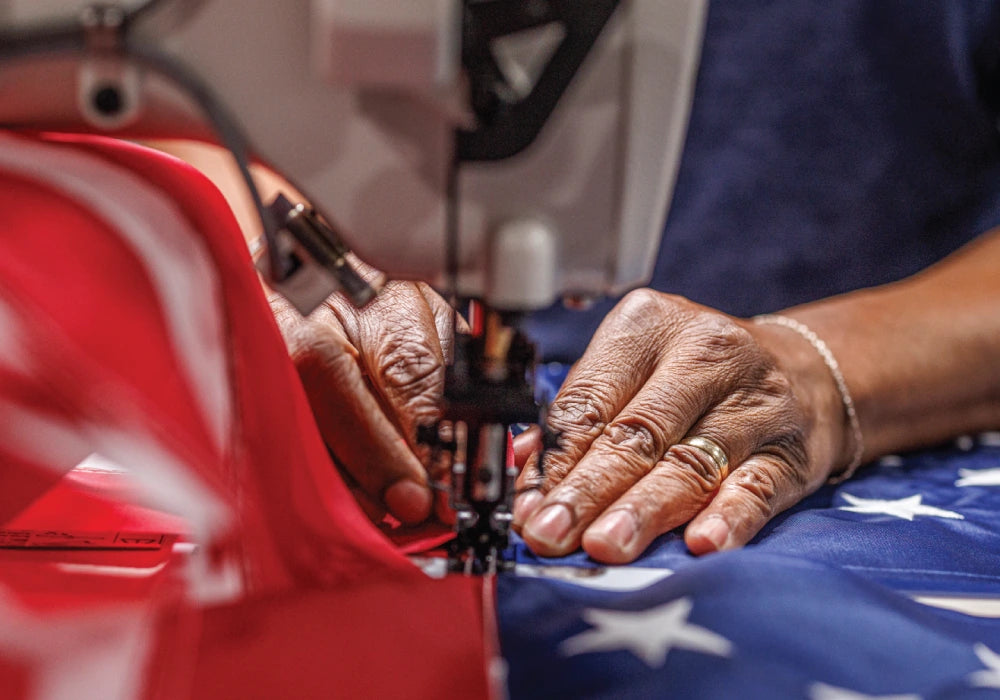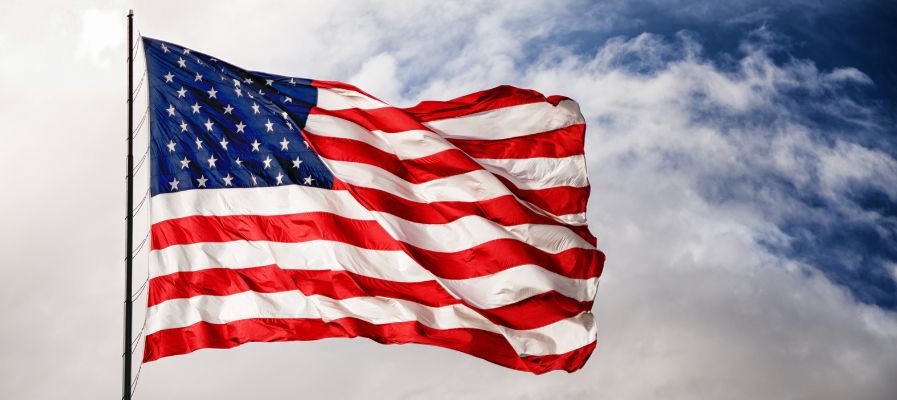Every American cherishes the red, white, and blue flag of America. This national symbol represents the core values of freedom, unity, and bravery. Recognizing its significance, it becomes paramount to find the perfect American flag. To support our local economy and ensure the highest quality, you should explore where to buy American flags. A well-known reputable US flag company online could be your perfect starting point that stands as a testament to your patriotism.
 Polyester and Nylon: A Closer Look
Polyester and Nylon: A Closer Look
Polyester in Detail
Polyester is a common material for flags. Its superior durability, excellent weather resistance, and commendable colorfastness make it a popular choice for outdoor displays. The fabric holds up exceptionally well in harsh weather conditions, including heavy rain and strong winds. Despite these advantages, the flags made of such material are usually heavier and may require more wind to fly effectively.
Nylon’s Characteristics
Comparatively, nylon, available in a United States flag store near you, is lightweight and flies effortlessly even in a gentle breeze. Its durability, colorfastness, and weather resistance are quite admirable, though not as exceptional as polyester. However, its standout feature is the vibrant look, which remains consistent over a considerable lifespan. On the downside, nylon may be more susceptible to UV damage.
Flag Construction and Attachment Styles
The way a flag is built and attached not only affects its appearance and longevity but is also closely tied to the type of fabric chosen. Polyester and nylon interact differently with construction and attachment methods, influencing which options are most suitable for your display needs:
-
Single- or Double-Stitched Seams: Flag seams are typically stitched once (single) or twice (double) along the edges. Double-stitched seams provide extra strength and are preferred for outdoor flags exposed to wind and weather. Polyester flags, being heavier, benefit greatly from double-stitching to prevent fraying, while lightweight nylon flags can perform well with single or double-stitching, depending on intended use and exposure.
-
Reinforced Fly Ends: The fly end, the edge farthest from the flagpole, endures the most stress. Reinforcing this area with extra stitching or a heavy-duty patch increases durability. Polyester’s robust nature pairs well with reinforced fly ends, making it ideal for harsh conditions. Nylon, while lighter, also benefits from reinforcement, especially for flags flown outdoors for extended periods.
-
Embroidered vs. Printed Stars and Stripes: Flags can feature embroidered or printed designs. Embroidered stars and stripes offer a classic, textured look and are usually found on higher-end or ceremonial flags, often made from heavier polyester. Printed designs are lighter and less expensive, commonly used on nylon flags where lightness and vibrant color are priorities.
-
Header and Grommet Attachments: The most common attachment for outdoor flags is a sturdy canvas header with brass grommets. This style works well with both polyester and nylon, but the heavier weight of polyester requires stronger headers and grommets to withstand tension. Nylon’s lighter weight is easier on these attachments, making it suitable for standard installations.
-
Pole Sleeve and Tab: This attachment method involves a sewn sleeve that slides directly over the flagpole, often secured internally with a small tab or strap to prevent the flag from slipping down. This style is highly favored for its seamless and elegant appearance, making it a popular choice for indoor displays, ceremonial events, and parades where a crisp, clean presentation is paramount. When considering fabric types, nylon's inherent flexibility and smooth drape make it exceptionally well-suited for pole sleeves, allowing the flag to slide on and off with ease and hang gracefully. In contrast, polyester, being a heavier and more rigid fabric, may necessitate additional reinforcement around the sleeve opening or along its length to ensure durability and prevent sagging over time. This reinforcement could include extra stitching, a double layer of fabric, or a more robust internal tab system to withstand the flag's weight. The choice between nylon and polyester for a pole sleeve and tab flag often comes down to the intended use and desired aesthetic, with nylon offering a lighter, more fluid look and polyester providing a more substantial and durable option, albeit with potential design considerations for its weight.
-
Rope and Thimble Attachments: For large or commercial flags, especially those flown on tall flagpoles, a rope sewn into the heading with a metal thimble provides maximum strength. Polyester’s durability is ideal for this heavy-duty attachment, which is designed to handle significant wind loads.
-
D-Ring Attachments: Flags used in marine or commercial settings use D-rings sewn into the header for secure attachment to specialized hardware. Polyester’s toughness ensures the rings remain firmly attached under stress, while nylon’s lightness makes installation easy but may require closer inspection for wear over time.
-
Appliqué and Sewn Construction: Appliqué involves sewing individual pieces of fabric onto the flag to create designs, while sewn construction uses panels stitched together. Both methods add dimension and durability, with polyester flags often using heavier thread and fabric for longevity. Nylon’s ease of handling makes it a popular choice for intricate appliqué work, resulting in vibrant, detailed flags.
The construction and attachment style of your flag should align with both your display environment and your chosen material. Understanding these differences ensures your flag remains a proud, enduring symbol wherever it’s displayed.
Selecting the Ideal Fabric for Your Flag
When planning to buy a USA flag, it's important to take into account your specific needs and preferences. One of the key factors to consider is the choice of fabric, as it can greatly impact the performance and longevity of the flag. The fabric choice is critical, particularly in relation to the size of the flag. For larger flags, nylon is often the preferred material. Its lightweight nature allows the flag to catch even the lightest breezes, ensuring it flies with ease and creates an attractive, flowing display. The inherent strength and durability of nylon also mean it can endure the wear and tear of being flown outdoors, resisting damage from UV rays and moisture. This resilience makes nylon ideal for flags that will be displayed prominently and frequently, such as national or corporate flags. Polyester, in contrast, is better suited for smaller flags due to its slightly heavier weight. This denser fabric provides a sturdier drape, allowing the flag to hang smoothly and visibly even in low wind conditions. The robust nature of polyester makes it particularly effective in windy environments where a heavier flag is necessary to prevent undue flipping and wrapping around the flagpole.
The location where you plan to display the flag is also a significant factor to consider. For areas with harsh weather conditions, such as strong winds or intense sunlight, a polyester flag will hold up better over time. It has greater resistance to fading, tearing, and fraying, making it a more durable option. Conversely, if you intend to use the flag indoors or in milder outdoor conditions, a nylon flag can provide a more vibrant display due to its ability to reflect light.
Another aspect to keep in mind is the expected lifespan of the flag. If you prefer to replace your flag periodically or have a limited budget, nylon flags offer affordability without compromising too much on quality. However, if you're seeking a longer-lasting flag that can withstand various weather conditions and extended outdoor exposure, investing in a durable polyester flag would be a wise choice. It's worth noting that the weight and denier count of the fabric significantly contribute to its strength and longevity. Higher denier counts generally indicate a stronger and more resilient fabric. So, when shopping for a USA flag, whether it's at a local United States flag store or online, remember to consider these factors to ensure you find the perfect flag that meets your specific needs and requirements.
 Polyester vs. Nylon: Setting the Record Straight
Polyester vs. Nylon: Setting the Record Straight
When searching for the ideal flag, it's important to address some common misconceptions about polyester and nylon head-on. One such misconception is that nylon flags are less durable than polyester. The reality is that both fabrics are known for their durability, with polyester potentially having a slight advantage due to its heavier construction.
Another misconception to dispel is the notion that polyester flags are less vibrant than nylon flags. Both materials retain their colors well over time. While nylon's slight shine may give the initial impression of more vibrant colors, both fabrics offer lasting beauty and vibrant displays when properly cared for. So, don't let these misconceptions sway your decision. Both have their strengths and qualities, and understanding the truth behind these misconceptions will help you make a well-informed choice based on your specific preferences and needs.
Taking Care of Your Flag
Regardless of whether you choose a polyester or nylon flag, proper care and maintenance are key to preserving its integrity. For polyester flags, it's essential to keep them clean to prevent dirt from damaging the fabric. Regular cleaning with a mild detergent can help maintain their appearance. It's also important to take them down in extreme weather conditions to prevent unnecessary wear and tear. As for nylon flags, it's best to keep them out of continuous direct sunlight to prevent UV damage. Regular cleaning is also recommended to maintain their vibrant look.
Environmental Impact and Sustainability
The environmental impact of each fabric, including its recyclability and overall ecological footprint, can influence your decision and reflect your commitment to sustainability. Below are some key ecological considerations to help you make an informed choice:
-
Resource Consumption and Manufacturing Impact: Polyester and nylon are both synthetic fabrics derived from petrochemicals, requiring significant energy and natural resources during production. The manufacturing process for polyester tends to consume slightly less energy than nylon, but both contribute to greenhouse gas emissions and environmental pollution. Choosing a flag made from recycled materials, when available, can help offset some of the environmental costs associated with new fabric production.
-
Recyclability and End-of-Life Options: Polyester flags are generally not easily recyclable due to the complexity of breaking down the fibers and the lack of widespread recycling programs. Nylon, on the other hand, can technically be recycled, but the process is complex and not widely accessible for consumers. As a result, most polyester and nylon flags end up in landfills at the end of their useful life, contributing to long-term environmental waste.
-
Ecological Footprint and Decomposition: Both polyester and nylon are non-biodegradable, meaning they persist in the environment for hundreds of years if not properly disposed of. Over time, these materials can break down into microplastics, which pose risks to wildlife and ecosystems. The ecological footprint of each fabric is thus significant, making it essential to consider ways to extend the lifespan of your flag or seek out eco-friendly alternatives.
-
Maximizing Lifespan to Reduce Environmental Impact: Regardless of the material, maximizing the lifespan of your flag is one of the most effective ways to reduce its overall ecological impact. Proper care, such as regular cleaning and timely repairs, can help extend the flag’s usability and delay disposal. By selecting a durable fabric and maintaining it properly, you can reduce the frequency of replacement and help minimize your environmental impact.
As sustainability becomes increasingly important, considering these factors ensures your choice aligns with both your patriotic values and environmental responsibility. Both fabrics have environmental considerations, but by taking proper care of your flag and maximizing its lifespan, you can help minimize your ecological footprint.
The journey to buy the perfect American flag kit is a journey of love for your nation. Whether you choose a polyester or nylon flag, remember that what truly matters is the pride and honor it represents. Every standard flag size, every fabric, every color embodies the spirit of the nation. Honor your values and showcase your pride by finding the perfect American flag today at Allegiance.
Sources:
-
Allegiance Flag Supply Shop Allegiance. https://www.showallegiance.com/collections/shop-allegiance
-
Allegiance Flag Supply. Flag Sets. https://www.showallegiance.com/collections/flag-sets





